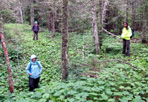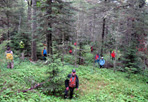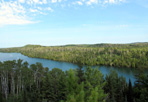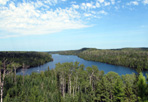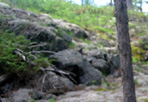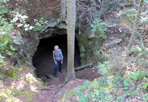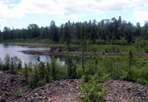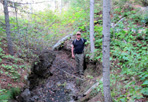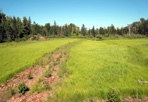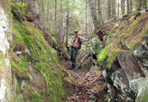
Minong Mine
By: Lawrence Rakestraw
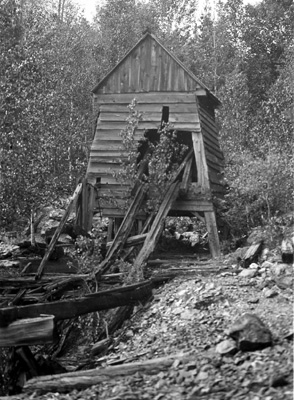
Minong Mine: Cooper Collection, Isle Royale National Park.
ear Minong Ridge in the McCargoe Cove area are hundreds of pits left by Indians who had mined for copper masses. These pits attracted the early attention of miners, and in 1874 three companies were formed in Detroit to exploit them-The Minong, the Cove, and the Ancient Mining companies. Of these three only the Minong was active; but the companies were essentially the same, since they had virtually the same officers and the same board of directors. The Minong Company obtained title from the North American Mineral Land Company to 1,455 acres along Minong Ridge. A year later they acquired the 1,190 acres of the Cove Company. With these holdings, virtually all the land between Lake Superior and Chickenbone Lake and west to Todd Harbor, was in their hands. S. W. Hill, who had been in charge of the exploring companies, described the possibilities in glowing terms. Abundant timber, he said, was available and well located; one road would command all the veins; and the old Indian workings would serve as guides to the best bodies of ore.
Work began in earnest in 1875. A substantial dock and warehouse were built at the mouth of McCargoe Cove, where lake steamers could unload goods and load copper ore. A tug and flat boats were used to transport goods through the narrow Z-shaped entrance to the cove and up two miles to the mine settlement. On September ninth Alonzo C. Davis, the agent, wrote, "The past three days have been big copper days for Minong." During this time they had taken out one mass weighing 6,000 pounds, another of 3,500-4,000 pounds, and still another of 2,500-3,000 pounds, besides much barrel stock and stamp copper. A wagon road had been built from the shore to the mining area and a railroad started, with about 600 feet of track laid at each end. Six dwellings had been completed in addition to a store and an office building. Fifty men were employed.
That winter was a hard one, with too much ice for boats and not enough for travel over the ice. Directors of the company, who had expected to have regular mail service by way of Pigeon River, became alarmed over the lack of communication so alarmed, indeed, that one director tried to get in touch with Davis through a medium. "Madame Blank" duly obliged with tales of large production in copper and silver. It is unlikely that Davis appreciated this attempted communication; his letters show him to have been a crusading agnostic! By May, however, Davis could report that the colony was still alive. During the winter they had taken out thirty tons of mass and barrel work, and a large pile of stamp rock. The population had remained static: two men had drowned in trying to carry mail to the mainland, and two children had been born.
There followed flush years for the Minong, with high production. Though two shafts were sunk, one to a depth of 300 feet, most of the work was a quarrying operation by means of open pits. A stamp mill was built powered by steam and obtaining water from a 12-foot high log dam on a tributary to Chickenbone Creek. A railroad led from the dock to the mine site; a spur of the railroad ran to the stamp mill, and another from the stamp mill to the ore dock. The blacksmith, with his shop located at the mine itself, must have been in great demand to shoe the many horses needed in hauling ore cars from the excavations to the railroad loading platforms and to repair the metal machinery. As the mining settlement grew, a schoolmaster was hired. Prosperity and a demand for self-government led to the establishment of Isle Royale County, with the county seat at Island Mine and the Minong settlement of Cove as a separate township.
By 1879, however, production began to fall off. Some of the difficulties were due to poor management, but more to poor rock. So long as large masses were available the mine prospered; but the stamp rock, about 1 ½% copper, could not be stamped and transported profitably. As the Ontonagon Herald remarked, "The ancients got the juice and left us moderns little but the acrid rind to nibble at." From 1881 to 1883 it was let on tribute-that is, leased for a share of the proceeds-and by 1885 it closed completely.
Image Gallery
Citation:
- Rakestraw, L., United States., & Isle Royale Natural History Association. (1965). Historic mining on Isle Royale. Houghton, Mich.: Isle Royale Natural History Association in cooperation with the National Park Service.
![Minong Mine Ruins, 1938: Hummel [NVIC: 30-157], ISRO Archives.](../Minong_Mine/Jpegs/Small/NVIC-30-157.jpg)
![Minong Mine Ruins, 1938: Hummel [NVIC: 30-159], ISRO Archives.](../Minong_Mine/Jpegs/Small/NVIC-30-159.jpg)
![Minong Mine Ruins, 1938: Hummel [NVIC: 30-160], ISRO Archives.](../Minong_Mine/Jpegs/Small/NVIC-30-160.jpg)
![Minong Mine Ruins, 1938: Hummel [NVIC: 30-157], ISRO Archives.](../Minong_Mine/Jpegs/Small/NVIC-30-161.jpg)
![Minong Mine Entrance, ca. 1940: [NVIC: 30-270], ISRO Archives.](../Minong_Mine/Jpegs/Small/NVIC-30-270.jpg)
![Minong Mine Ruins, ca. 1940: [NVIC: 30-271], ISRO Archives.](../Minong_Mine/Jpegs/Small/NVIC-30-271.jpg)
![Minong Mine Ruins, ca. 1940: [NVIC: 30-272], ISRO Archives.](../Minong_Mine/Jpegs/Small/NVIC-30-272.jpg)
![Minong Mine Ruins, ca. 1940: [NVIC: 30-273], ISRO Archives.](../Minong_Mine/Jpegs/Small/NVIC-30-273.jpg)

